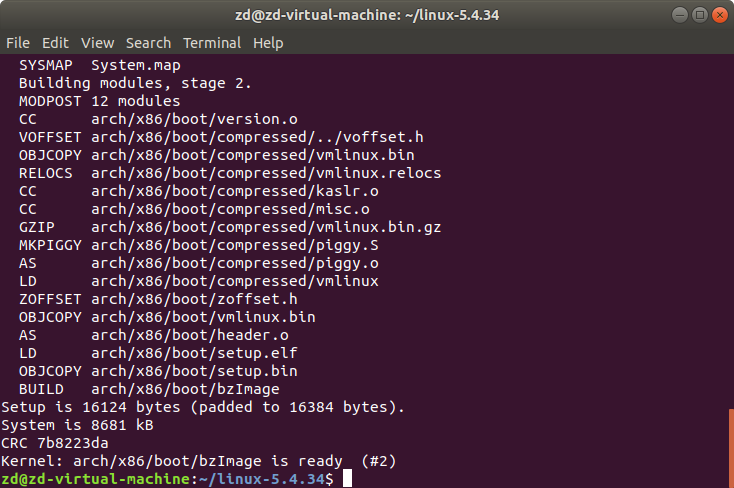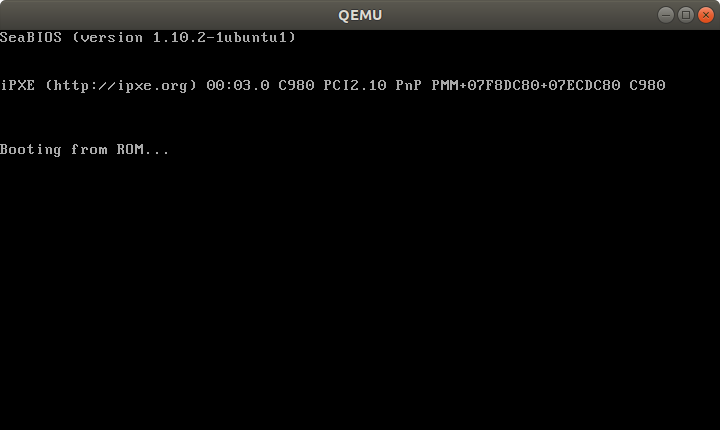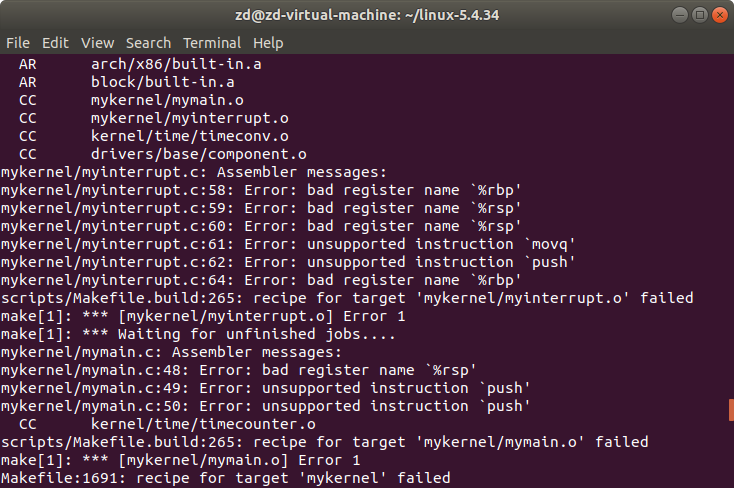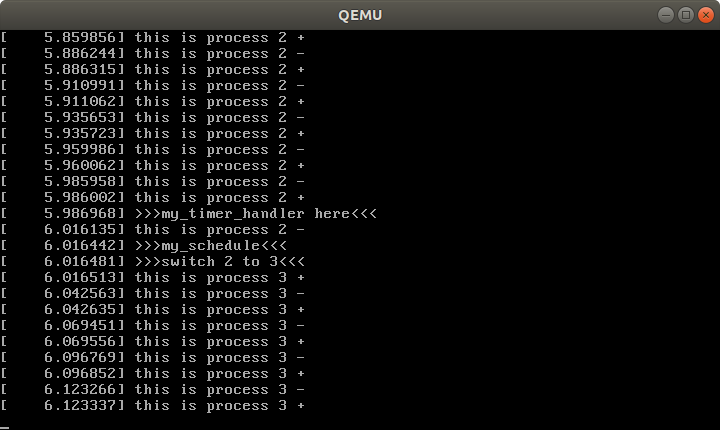一、配置实验环境
1、虚拟机的系统为Ubuntu 18.04,按照https://github.com/mengning/mykernel中提供的命令配置即可。
wget https://raw.github.com/mengning/mykernel/master/mykernel-2.0_for_linux-5.4.34.patch sudo apt install axel axel -n 20 https://mirrors.edge.kernel.org/pub/linux/kernel/v5.x/linux-5.4.34.tar.xz xz -d linux-5.4.34.tar.xz tar -xvf linux-5.4.34.tar cd linux-5.4.34 patch -p1 < ../mykernel-2.0_for_linux-5.4.34.patch sudo apt install build-essential gcc-multilib sudo apt install qemu # install QEMU sudo apt install libncurses-dev bison flex libssl-dev libelf-dev make defconfig # Default configuration is based on 'x86_64_defconfig' make -j$(nproc) qemu-system-x86_64 -kernel arch/x86/boot/bzImage
在安装依赖时可能会出现类似于E: Unable to locate package flex的错误,可以尝试切换Ubuntu镜像源,并执行sudo apt-get update即可,最好单独执行那个依赖的安装命令。
2、配置完成,进行Linux内核的编译,编译完成后如下图所示。

3、运行qemu,结果如下,可以看到my_start_kernel在执行,同时my_timer_handler时钟中断处理程序周期性执行。

4、对于老师上课所说的使用make allnoconfig进行编译,通过查找资料,发现make allnoconfig是除必须的选项外,其它选项一律不选. (常用于嵌入式系统)。而老师使用的make defconfig,一般是默认的配置方式,与机器的平台有关。 尝试使用make allnoconfig进行编译,可以看到编译配置文件中输出格式为i386。

编译完成后使用命令
qemu-system-i386 -kernel arch/i386/boot/bzImage
发现会卡在如下界面

如果将mykernel文件夹替换成https://github.com/mengning/mykernel中的文件,重新编译会出现编译错误,不支持某些指令。

对于出现的错误,查找资料后并没有找到好的解决方法,所以最后还是按照老师提供的命令进行编译来完成实验。
二、基于mykernel 2.0编写一个操作系统内核
参照https://github.com/mengning/mykernel 提供的范例代码,将mykernel文件夹中的文件进行修改即可。
1、增加mypcb.h,进程控制块PCB结构体定义。
/* * linux/mykernel/mypcb.h * * Kernel internal PCB types * * Copyright (C) 2013 Mengning * */ #define MAX_TASK_NUM 4 #define KERNEL_STACK_SIZE 1024*2 /* CPU-specific state of this task */ //存储ip,sp struct Thread { unsigned long ip; unsigned long sp; }; typedef struct PCB{ int pid; //进程的id volatile long state; /* 进程状态 -1 unrunnable, 0 runnable, >0 stopped */ unsigned long stack[KERNEL_STACK_SIZE]; //进程堆栈 /* CPU-specific state of this task */ struct Thread thread; unsigned long task_entry; //进程入口, struct PCB *next; //指向下一个进程PCB }tPCB; //调度函数 void my_schedule(void);
2、mymain.c,首先调用my_start_kernel函数,启动0号进程并创建了其它进程PCB,在my_process函数中,根据my_need_sched变量,判断当前进程是否进行调度。
/* * linux/mykernel/mymain.c * * Kernel internal my_start_kernel * Change IA32 to x86-64 arch, 2020/4/26 * * Copyright (C) 2013, 2020 Mengning * */ #include <linux/types.h> #include <linux/string.h> #include <linux/ctype.h> #include <linux/tty.h> #include <linux/vmalloc.h> #include "mypcb.h" tPCB task[MAX_TASK_NUM]; //声明tPCB类型的数组 tPCB * my_current_task = NULL; //声明当前task的指针 volatile int my_need_sched = 0; //判断是否需要调度 void my_process(void); void __init my_start_kernel(void) { int pid = 0; int i; /* Initialize process 0*/ task[pid].pid = pid; //初始化0号进程 task[pid].state = 0;/* -1 unrunnable, 0 runnable, >0 stopped */ task[pid].task_entry = task[pid].thread.ip = (unsigned long)my_process; //入口 task[pid].thread.sp = (unsigned long)&task[pid].stack[KERNEL_STACK_SIZE-1]; task[pid].next = &task[pid]; /*fork more process */ for(i=1;i<MAX_TASK_NUM;i++) //复制创建其他进程 { memcpy(&task[i],&task[0],sizeof(tPCB)); task[i].pid = i; task[i].thread.sp = (unsigned long)(&task[i].stack[KERNEL_STACK_SIZE-1]); task[i].next = task[i-1].next; task[i-1].next = &task[i]; } /* start process 0 by task[0] */ pid = 0; my_current_task = &task[pid]; asm volatile( "movq %1,%%rsp " /* set task[pid].thread.sp to rsp */ "pushq %1 " /* push rbp */ "pushq %0 " /* push task[pid].thread.ip */ "ret " /* pop task[pid].thread.ip to rip */ : : "c" (task[pid].thread.ip),"d" (task[pid].thread.sp) /* input c or d mean %ecx/%edx*/ ); } int i = 0; void my_process(void) { while(1) { i++; if(i%10000000 == 0) { printk(KERN_NOTICE "this is process %d - ",my_current_task->pid); if(my_need_sched == 1) //判断是否需要调度 { my_need_sched = 0; my_schedule(); } printk(KERN_NOTICE "this is process %d + ",my_current_task->pid); } } }
3、myinterrupt.c,时钟中断处理和进程调度算法。my_timer_handler函数记录时间,每经过固定的时间片就执行调度,通过调用my_schedule函数,如果下一个进程状态时runnable,就进行进程的切换。
/* * linux/mykernel/myinterrupt.c * * Kernel internal my_timer_handler * Change IA32 to x86-64 arch, 2020/4/26 * * Copyright (C) 2013, 2020 Mengning * */ #include <linux/types.h> #include <linux/string.h> #include <linux/ctype.h> #include <linux/tty.h> #include <linux/vmalloc.h> #include "mypcb.h" extern tPCB task[MAX_TASK_NUM]; extern tPCB * my_current_task; extern volatile int my_need_sched; volatile int time_count = 0; /* * Called by timer interrupt. * it runs in the name of current running process, * so it use kernel stack of current running process */ void my_timer_handler(void) { if(time_count%1000 == 0 && my_need_sched != 1) //控制时间片的大小,设置调度的标志 { printk(KERN_NOTICE ">>>my_timer_handler here<<< "); my_need_sched = 1; } time_count ++ ; return; } void my_schedule(void) //进程切换 { tPCB * next; tPCB * prev; if(my_current_task == NULL || my_current_task->next == NULL) { return; } printk(KERN_NOTICE ">>>my_schedule<<< "); /* schedule */ next = my_current_task->next; prev = my_current_task; if(next->state == 0)/* -1 unrunnable, 0 runnable, >0 stopped 根据下一个进程的状态来判断是否切换*/ { my_current_task = next; printk(KERN_NOTICE ">>>switch %d to %d<<< ",prev->pid,next->pid); /* switch to next process */ asm volatile( "pushq %%rbp " /* save rbp of prev */ "movq %%rsp,%0 " /* save rsp of prev */ "movq %2,%%rsp " /* restore rsp of next */ "movq $1f,%1 " /* save rip of prev ,%1f指接下来的标号为1的位置*/ "pushq %3 " "ret " /* restore rip of next */ "1: " /* next process start here */ "popq %%rbp " : "=m" (prev->thread.sp),"=m" (prev->thread.ip) : "m" (next->thread.sp),"m" (next->thread.ip) ); } return; }
4、利用修改后的代码,重新编译运行,得到下面的结果,可以看到进程的切换。

三、操作系统内核核心功能及运行工作机制
1、内核核心功能是mymain.c和myinterrupt.c中的两段汇编代码,下面逐一分析。
asm volatile( "movq %1,%%rsp " /* set task[pid].thread.sp to rsp */ "pushq %1 " /* push rbp */ "pushq %0 " /* push task[pid].thread.ip */ "ret " /* pop task[pid].thread.ip to rip */ : : "c" (task[pid].thread.ip),"d" (task[pid].thread.sp) /* input c or d mean %ecx/%edx*/ );
mymain.c中的这一段汇编代码进行0号进程的启动。
(1)将task[0].thread.sp拿去修改rsp的值,这时候内核堆栈的栈顶指针rsp指向task[0]的栈顶;
(2)在task[0]的sp位置处压入rbp的值,来保护原来的内核堆栈;
(3)设置task[0].thread.ip的值给rip,这样就能够保证cpu下一步能够执行0号进程,完成了进入my_process()的过程。
此时eip的值已经被修改,指令进入my_process(),所以最后一句的ret并不会被立即执行了。
myinterrupt.c中的这段汇编代码用于进程切换。
(1)保存prev进程的rbp值到堆栈中。
(2)修改prev->thread.sp的值为当前rsp寄存器的值,保存prev进程的栈顶指针。
(3)将next->thread.sp的值赋给rsp寄存器,完成进程的切换。
(4)保存prev进程rip寄存器值到prev->thread.ip,这里$1f是指标号1。
(5)把即将执行的next进程的指令地址next->thread.ip入栈。
(6)ret 就是将压入栈中的next->thread.ip放入rip寄存器,rip寄存器现在存储next进程的指令。
(7)1: 标号1是一个特殊的地址位置,该位置的地址是$1f。
(8)next进程栈底从堆栈中恢复到rbp寄存器中,开始next进程的执行。
2、运行工作机制
程序的运行过程如下:首先从my_start_kernel函数开始,启动并初始化0号进程,并通过复制创建其他的进程。接着进入my_process函数,通过死循环不同重复变量i的自增,每10000000次检查my_need_sched变量,同时内核周期性调用my_timer_handler函数,通过time_count变量的自增来控制时间片,当时间片结束时,将my_need_sched变量的值修改为1,此时如果my_process函数中检测到my_need_sched的值为1,便调用my_schedule函数,进行进程调度。不断循环。
四、小结
在这次实验中,首先完成了实验环境的配置和linux内核编译,通过尝试不同的编译配置方法,对编译内核有了更深的理解。接着通过范例代码,对时间片进程调度算法进行分析,堆栈,rsp,rbp,rip等在进程切换的过程中对上下文的保存和切换有着重要的作用。